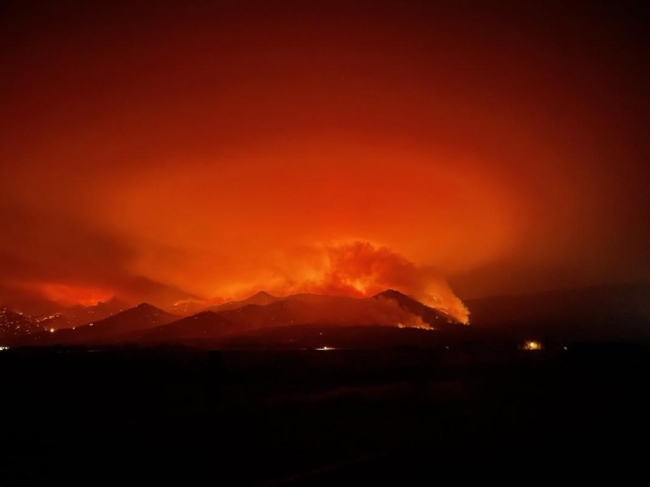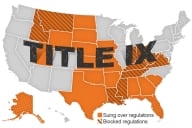You have /5 articles left.
Sign up for a free account or log in.

California community colleges struggle to serve their surrounding communities as fires rage on.
Trevor Albertson
A haze of smoke rests on Lake Tahoe Community College as the Caldor fire makes its way into the Lake Tahoe Basin. The area is emptying as nearby residents respond to evacuation orders in South Lake Tahoe.
"We’re kind of like a smoky, eerie ghost town right now," said Jeff DeFranco, president and superintendent of the college.
It’s certainly not the triumphant return to campus he hoped for this fall after the college operated remotely for more than a year due to the pandemic.
DeFranco and other leaders of California community colleges now find themselves struggling to meet the manifold needs of students as multiple fires continue to spread across the state during the start of an already fraught academic year. In addition to supporting students, staff and faculty members, some colleges are also having to shelter affected residents of communities near the campuses.
“I always joke, they didn’t teach me this in presidents’ school,” DeFranco said.
Lake Tahoe Community College planned to start in-person classes Sept. 13 but pushed the start date back a week shortly after Christmas Valley, a neighborhood where some faculty and students live, got an evacuation warning last Thursday. The college previously announced it would closed its campus from Aug. 16 through Sept. 6 and moved a major registration drive and all its other student services online in response to the fire. All virtual services were subsequently shut down until after Labor Day to give faculty, staff and students time to evacuate. DeFranco estimated at least 80 percent of campus employees were forced to leave the area, himself included. Now he’s unsure whether the first day of classes will take place virtually or on campus.
Early September would usually be “prime time” for students to come to campus to consult with academic advisers and register for classes, but registration is down this year, and the tumult ahead of the fall term is not likely to help. The 1,049 students registered for courses this fall so far is 17.5 percent lower than the 1,272 students registered last fall. The institution, like many community colleges across the country, had already faced a double-digit enrollment decline over all during the pandemic.
“It’s really just impacting students’ ability to get in and get registered and get enrolled,” DeFranco said. “Everyone is distracted by the fires, in my opinion.”
He said he and his colleagues are "glued to their computers" looking at fire maps and YouTube videos of the fires, trying to assess if their neighborhoods are safe.
DeFranco pointed out that the experience of shifting online during the pandemic helped the college respond to the fire with more knowledge about how to quickly switch to virtual services.
“Pre-COVID, if I would’ve shut down the campus, there would be no way to serve students,” he said.
Daisy Gonzales, acting chancellor of the California Community College System, said the pandemic has also given colleges experience working together to confront a crisis.
She said she saw college leaders "come together like a family" during the pandemic and cooperate in ways that felt "new" and "different."
Joe Wyse, president and superintendent of Shasta College, for example, said other college leaders have turned to him for advice on fire-related issues such as whether to give employees extra leave time or whether the Board of Trustees should declare an official emergency. Shasta was badly affected by the Carr fire in 2018. At least 30 students and 19 employees lost their homes, and the college housed local evacuees -- more than 1,000 people at the height of the crisis -- for several weeks.
The wildfires this summer have been “relatively easy to manage” by comparison, he said, but the pandemic has made things more stressful over all.
“We’ve got a good network here where we can call each other and ask questions … and serve as resources for each other,” Wyse said.
The combination of COVID-19 and the fires still poses logistical challenges, however.
DeFranco noted that the college recently changed its building ventilation systems to bring in more outside air to help prevent the spread of infection. That safety measure risks bringing hazardous, smoky air into campus buildings, a problem he believes many California campuses will have to handle, even if they’re not directly in the path of a fire.
Gonzales said the greatest impact of the fires on colleges has been “the compounding effect of living under crisis.” She sees this moment as a triple crisis and a particularly challenging time for low-income community college students already dealing with the personal and financial costs of the pandemic, the unpredictability of the fires, and the overall disruption to their lives from both events.
“As we think about these fires, we think about extreme needs,” she said. “Many of our students were already facing food and housing insecurity. The pandemic only made it worse.”
And it’s not just students who have been affected.
“We have so many faculty, staff and students who have lost their homes,” Gonzales said. “That’s something unimaginable.”
DeFranco believes the role of a college leader has also changed in response to the crises this year.
“Higher education leaders just are facing challenges that we’ve never had to deal with before,” he said. “Our biggest concerns used to be budgets and student success and how are enrollments. But now we’re dealing with a global pandemic and fire on our doorsteps. It’s a different world right now as a higher education leader.”
The fires have so far not damaged any of the community colleges in the system, according to Gonzales. However, damage to the infrastructure of communities surrounding the campuses will have to be assessed for the potential impact on the colleges and students.
A couple of colleges have also served as evacuation shelters for residents of surrounding communities affected by the fires.
Shasta College’s gym operated as a Red Cross evacuation center and housed between a dozen and 45 evacuees from the Monument fire per night from Aug. 8 through Aug. 30. The fires also mean sports teams can’t practice outside on days with poor air quality. The college had temporarily shut down a small satellite campus in Weaverville, as well, because of its proximity to the fires.
Lassen Community College volunteered to house evacuees from the Dixie fire and served as a shelter for up to 500 local residents from July 23 through last week. Trevor Albertson, president and superintendent of Lassen, described people living in RVs in the college’s parking lot, in tents on the lawn and in the campus gym. Firefighters slept in math and science classrooms, and evacuees ate in the cafeteria. Community members dropped off supplies for evacuees, everything from quilts to watermelons, he said. Some students and board members also volunteered through the Red Cross and Salvation Army.
“I think our students learned a lot about what public service is all about,” Albertson said.
Lassen students were on campus for in-person classes for just one day, Aug. 16, before the college had to close for a week. The college moved more than 100 students living in the dorms to Humboldt State University because of the bad air quality near Lassen.
“There was a huge evacuation -- the smoke was really bad, ash was raining down on campus and we had to get everybody out of here,” Albertson said. “I essentially shuttered the campus.”
Classes were paused until Aug. 23, and the college held classes online last week before returning to campus Monday. The shelter also closed last week after conditions in the area improved. Albertson estimated the fire cost the college up to $50,000, including expenses related to housing evacuees and "soft costs" such as lost hours of work.
Adam Runyan, an academic counselor and president of the Academic Senate at the college, said the beginning of the fall term has been understandably “hit or miss.”
He said some faculty members had to evacuate their homes and struggled to connect with students online and teach their first week of courses, which led to some confusion for students. Meanwhile, he estimates a third of students live in areas where houses were in danger of burning or have already burned down.
“The faculty totally feel for the students because they’re in the same situation,” he said.
The number of students taking courses at the college is up from last year, in spite of the chaos. The head count was 5,388 students on Monday, up from 5,200 last fall.
Runyan said some students withdrew because of challenges posed by the fires, but a couple of the evacuees registered for courses while living on campus, and the college’s fire science program now has a wait list.
The need for the program “is in our faces,” he said. “It’s viscerally here. We wake up, we smell it, we feel it.”
Albertson called California a “land of extremes.” He believes the fires bring lessons taught in the classroom about climate change to life.
“It’s a question of whether or not communities, and in this case higher education, can adapt fast enough to live,” he said.









